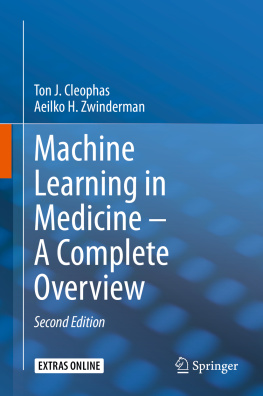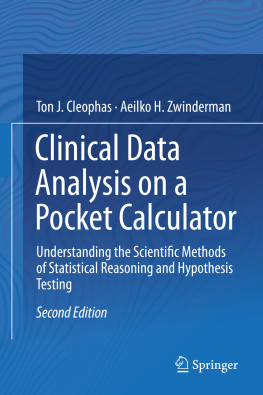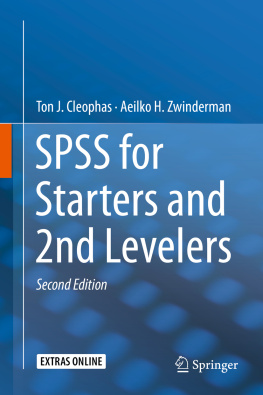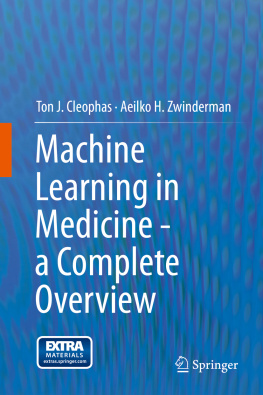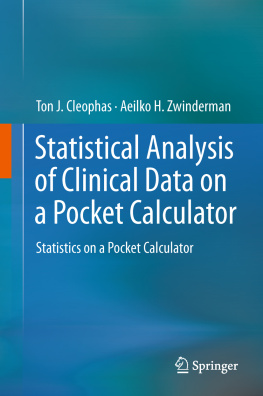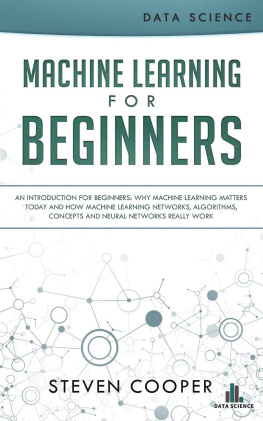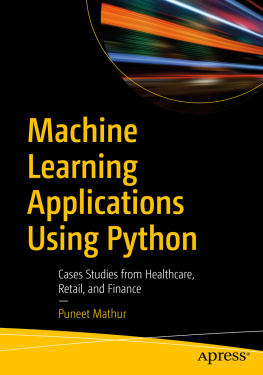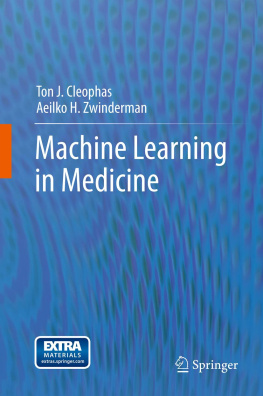Ton J. Cleophas - Machine Learning in Medicine – A Complete Overview
Here you can read online Ton J. Cleophas - Machine Learning in Medicine – A Complete Overview full text of the book (entire story) in english for free. Download pdf and epub, get meaning, cover and reviews about this ebook. year: 2020, publisher: Springer International Publishing, genre: Home and family. Description of the work, (preface) as well as reviews are available. Best literature library LitArk.com created for fans of good reading and offers a wide selection of genres:
Romance novel
Science fiction
Adventure
Detective
Science
History
Home and family
Prose
Art
Politics
Computer
Non-fiction
Religion
Business
Children
Humor
Choose a favorite category and find really read worthwhile books. Enjoy immersion in the world of imagination, feel the emotions of the characters or learn something new for yourself, make an fascinating discovery.
- Book:Machine Learning in Medicine – A Complete Overview
- Author:
- Publisher:Springer International Publishing
- Genre:
- Year:2020
- Rating:3 / 5
- Favourites:Add to favourites
- Your mark:
- 60
- 1
- 2
- 3
- 4
- 5
Machine Learning in Medicine – A Complete Overview: summary, description and annotation
We offer to read an annotation, description, summary or preface (depends on what the author of the book "Machine Learning in Medicine – A Complete Overview" wrote himself). If you haven't found the necessary information about the book — write in the comments, we will try to find it.
Machine Learning in Medicine – A Complete Overview — read online for free the complete book (whole text) full work
Below is the text of the book, divided by pages. System saving the place of the last page read, allows you to conveniently read the book "Machine Learning in Medicine – A Complete Overview" online for free, without having to search again every time where you left off. Put a bookmark, and you can go to the page where you finished reading at any time.
Font size:
Interval:
Bookmark:
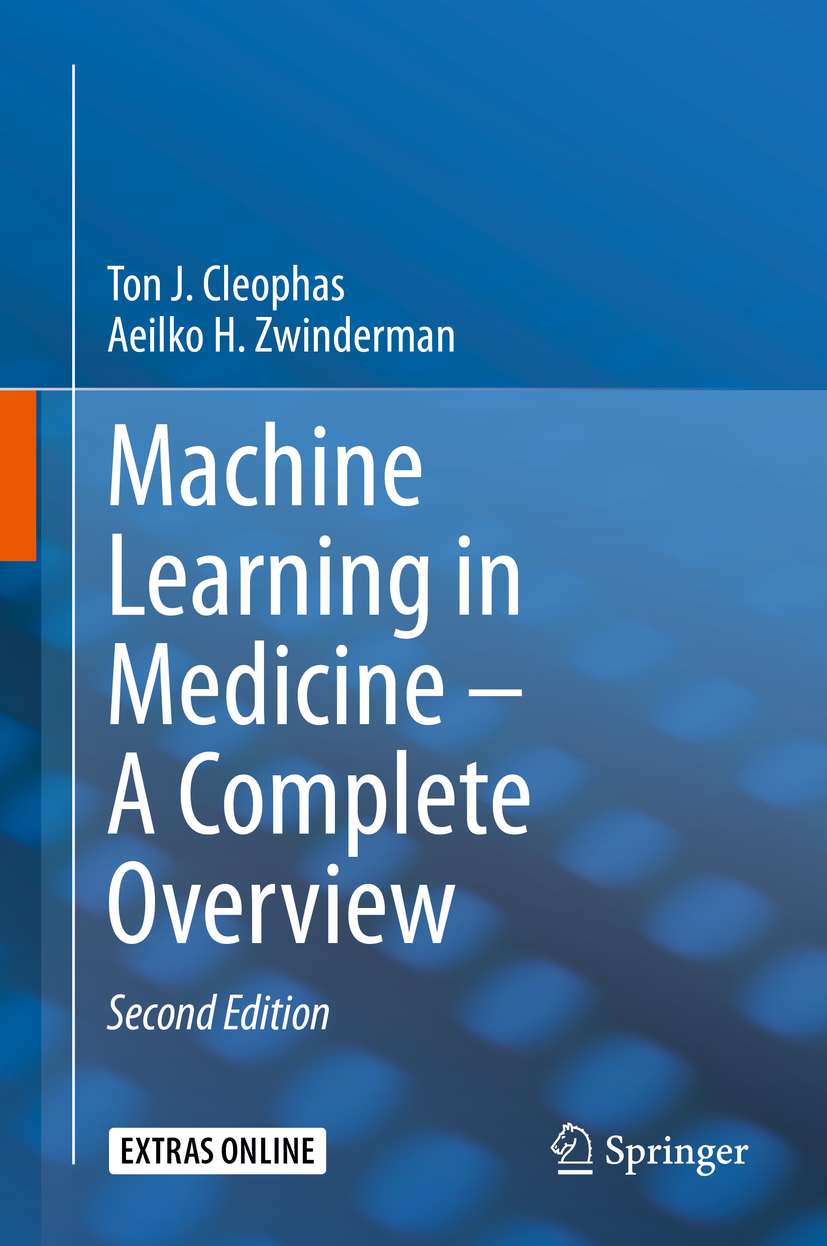

This Springer imprint is published by the registered company Springer Nature Switzerland AG.
The registered company address is: Gewerbestrasse 11, 6330 Cham, Switzerland
In the second edition, the authors will remove the textual errors from the first edition. Also, the improved tables from the first edition will be replaced with the original tables from the software programs as applied. This is, because, unlike the former, the latter were without error and the readers were better familiar with them.
The main purpose of the first edition was to provide stepwise analyses of the novel methods from data examples, but background information and clinical relevance information may have been somewhat lacking. Therefore, each chapter will now contain a section entitled Background Information.
Machine learning may be more informative and may provide better sensitivity of testing than traditional analytic methods may do. In the second edition, a place will be given for the use of machine learning not only to the analysis of observational clinical data but also to that of controlled clinical trials.
Unlike the first edition, the second edition will have drawings in full color, providing a helpful extra dimension to the data analysis.
Several machine learning methodologies not yet covered in the first edition, but increasingly important today, will be included in this updated edition, for example, negative binomial and Poisson regressions, sparse canonical analysis, Firths bias adjusted logistic analysis, omics research, eigenvalues, and eigenvectors.
The amount of data stored in the worlds databases doubles every 20 months, as estimated by Usama Fayyad, one of the founders of machine learning and co-author of the book Advances in knowledge discovery and data mining (ed. by the American Association for Artificial Intelligence, Menlo Park, CA, USA, 1996), and clinicians, familiar with traditional statistical methods, are at a loss to analyze them.
Traditional methods have, indeed, difficulty to identify outliers in large datasets, and to find patterns in big data and data with multiple exposure / outcome variables. In addition, analysis-rules for surveys and questionnaires, which are currently common methods of data collection, are, essentially, missing. Fortunately, the new discipline, machine learning, is able to cover all of these limitations.
So far medical professionals have been rather reluctant to use machine learning. Ravinda Khattree, co-author of the book Computational methods in biomedical research (ed. by Chapman & Hall, Baton Rouge, LA, USA, 2007) suggests that there may be historical reasons: technological (doctors are better than computers (?)), legal, cultural (doctors are better trusted). Also, in the field of diagnosis making, few doctors may want a computer checking them, are interested in collaboration with a computer or with computer engineers.
Adequate health and health care will, however, soon be impossible without proper data supervision from modern machine learning methodologies like cluster models, neural networks, and other data mining methodologies. The current book is the first publication of a complete overview of machine learning methodologies for the medical and health sector, and it was written as a training companion, and as a must-read, not only for physicians and students, but also for any one involved in the process and progress of health and health care.
Some of the 80 chapters have already appeared in Springers Cookbook Briefs, but they have been rewritten and updated. All of the chapters have two core characteristics. First, they are intended for current usage, and they are, particularly, concerned with improving that usage. Second, they try and tell what readers need to know in order to understand the methods.
In a nonmathematical way stepwise analyses of the underneath three most important classes of machine learning methods will be reviewed:
cluster and classification models (Chaps. 118),
(log) linear models (Chaps. 1949),
rules models (Chaps. 5080).
The book will include basic methodologies like typology of medical data, quantile-quantile plots for making a start with your data, rate analysis and trend analysis as more powerful alternatives to risk analysis and traditional tests, probit models for binary effects on treatment frequencies, higher order polynomes for circadian phenomena, contingency tables and its myriad applications. Particularly, the Chaps. 9, 14, 15, 18, 45, 48, 49, 79, and 80 will review these methodologies.
The Chap. 7 describes the use of visualization processes instead of calculus methods for data mining. The Chap. 8 describes the use of trained clusters, a scientifically more appropriate alternative to traditional cluster analysis. The Chap. 69 describes evolutionary operations (evops), and the evop calculators, already widely used for chemical and technical process improvement.
Various automated analyses and simulation models are in the Chaps. 4, 29, 31, and 32. The Chaps. 67, 70, 71 review spectral plots, Bayesian networks, support vector machines. A first description of several methods already employed by technical and market scientists, and of their suitabilities for clinical research is given in the Chaps. 3739, 56 (ordinal scalings for inconsistent intervals, loglinear models for varying incident risks, iteration methods for crossvalidations).
Font size:
Interval:
Bookmark:
Similar books «Machine Learning in Medicine – A Complete Overview»
Look at similar books to Machine Learning in Medicine – A Complete Overview. We have selected literature similar in name and meaning in the hope of providing readers with more options to find new, interesting, not yet read works.
Discussion, reviews of the book Machine Learning in Medicine – A Complete Overview and just readers' own opinions. Leave your comments, write what you think about the work, its meaning or the main characters. Specify what exactly you liked and what you didn't like, and why you think so.

